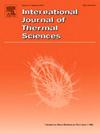在亚大气压力下,微型鳍状散热器中水的流动沸腾
IF 4.9
2区 工程技术
Q1 ENGINEERING, MECHANICAL
International Journal of Thermal Sciences
Pub Date : 2025-05-30
DOI:10.1016/j.ijthermalsci.2025.110032
引用次数: 0
摘要
实验研究了去离子水在亚大气出口压力下在硅基微鳍片散热器中的流动沸腾。实验的质量流量为4 ml/min,控制出口压力为20 ~ 60 kPa,有效热流密度为580 kW/m2。进口温度控制在低于与出口压力相对应的饱和温度20k。研究和讨论了亚大气出口压力对流动沸腾特性的影响。研究发现,由于气相密度的显著降低,亚大气出口压力越低,压降越高。当出口热力质量约为0.27时,在Pout = 20 kPa时,压降约为14.87 kPa,而在Pout = 60 kPa时,压降仅为8.50 kPa。同时,Pout = 60 kPa时的平均换热系数约为Pout = 20 kPa时的两倍。此外,壁面温度沿流动方向呈下降趋势,这是由于饱和温度沿微翅片散热器方向呈下降趋势所致。出口压力较低时,换热性能下降较早。流动沸腾的可视化结果表明,在出口亚大气压下,上游气泡的快速膨胀和下游薄液膜的蒸发是微鳍片散热器的主要流动沸腾行为。上游气泡的膨胀是下游液体补充的重要动力。本文章由计算机程序翻译,如有差异,请以英文原文为准。
Flow boiling of water in a micro pin-fin heat sink at sub-atmospheric pressure
Flow boiling of deionized water in a silicon-based micro pin-fin heat sink with sub-atmospheric outlet pressure are experimentally studied in this work. Experiments are conducted with a constant mass flow rate of 4 ml/min, a controlled outlet pressure ranging from 20 to 60 kPa, and effective heat flux up to 580 kW/m2. The inlet temperature is controlled at 20 K below the saturation temperature corresponding to the outlet pressure. The effects of sub-atmospheric outlet pressure on the flow boiling characteristics are investigated and discussed. It is found that lower sub-atmospheric outlet pressure leads to higher pressure drop due to the significant reduction in vapor phase density. When the outlet thermodynamic quality is about 0.27, the pressure drop is about 14.87 kPa at Pout = 20 kPa, while it is only 8.50 kPa at Pout = 60 kPa. In the meantime, the average heat transfer coefficient at Pout = 60 kPa is approximately twice that at Pout = 20 kPa. Besides, a decreasing tendency of wall temperature along the flow direction is observed, which is caused by the decreasing tendency of saturation temperature along the micro pin-fin heat sink. Under lower outlet pressure condition, the heat transfer performance degradation occurs earlier. The flow boiling visualization results show that the rapid expansion behavior of upstream bubbles and the evaporation of the thin liquid film in the downstream area are the main flow boiling behaviors in micro pin-fin heat sink under outlet sub-atmospheric pressure. The expansion of upstream bubbles is an important driving force for the replenishment of downstream liquid.
求助全文
通过发布文献求助,成功后即可免费获取论文全文。
去求助
来源期刊

International Journal of Thermal Sciences
工程技术-工程:机械
CiteScore
8.10
自引率
11.10%
发文量
531
审稿时长
55 days
期刊介绍:
The International Journal of Thermal Sciences is a journal devoted to the publication of fundamental studies on the physics of transfer processes in general, with an emphasis on thermal aspects and also applied research on various processes, energy systems and the environment. Articles are published in English and French, and are subject to peer review.
The fundamental subjects considered within the scope of the journal are:
* Heat and relevant mass transfer at all scales (nano, micro and macro) and in all types of material (heterogeneous, composites, biological,...) and fluid flow
* Forced, natural or mixed convection in reactive or non-reactive media
* Single or multi–phase fluid flow with or without phase change
* Near–and far–field radiative heat transfer
* Combined modes of heat transfer in complex systems (for example, plasmas, biological, geological,...)
* Multiscale modelling
The applied research topics include:
* Heat exchangers, heat pipes, cooling processes
* Transport phenomena taking place in industrial processes (chemical, food and agricultural, metallurgical, space and aeronautical, automobile industries)
* Nano–and micro–technology for energy, space, biosystems and devices
* Heat transport analysis in advanced systems
* Impact of energy–related processes on environment, and emerging energy systems
The study of thermophysical properties of materials and fluids, thermal measurement techniques, inverse methods, and the developments of experimental methods are within the scope of the International Journal of Thermal Sciences which also covers the modelling, and numerical methods applied to thermal transfer.
 求助内容:
求助内容: 应助结果提醒方式:
应助结果提醒方式:


